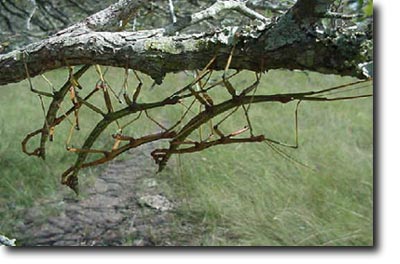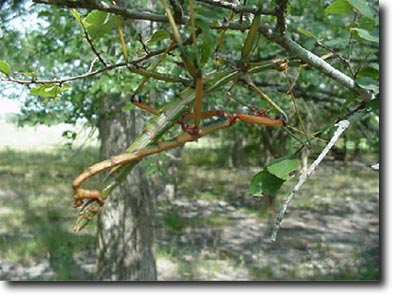Walkingsticks are unusual and striking insects that mimic sticks and twigs in a remarkable way. Most people are familiar with these interesting insects. Texas can lay claim to the longest insect found in the United States – a species of walkingstick that may reach seven inches in length. It is commonly called the giant walkingstick and has the scientific name Megaphasma dentricrus.
The giant walkingstick occasionally can be found in large numbers in localized areas of Texas. In June of 1981 and again in June 2000, unusual localized outbreaks of this walkingstick were observed. In 1981 the area was along state highway 71 just west of Bastrop (Bastrop County). Trees (primarily oaks) on the north side of the highway exhibited noticeable defoliation, while the same host type on the south side of the highway was not affected. In 2000, the outbreak area occurred in one small drainage about four miles northeast of Navasota (Grimes County). Here the host type was primarily Osage-orange (Maclura pomifera), also called Bois-d’arc, and cedar elm (Ulmus crassifolia).
Much folklore is associated with walkingsticks, especially large ones. They are sometimes called a devil’s horse, and some people believe they can spit blood in your eyes. This is not true. Also, many believe that walkingsticks can sting, but this is not true, either. Males have claspers at the end of their abdomen (see photo below) that look dangerous, but they are not. The insects may appear intimidating and when picked up their feet can cling very tightly to skin and clothing, but they are completely harmless. Walkingsticks are docile, slow moving, herbivores that are mainly concerned with looking like a stick (excellent camouflage), eating leaves, and mating.
When large numbers of giant walkingsticks are present, they may completely defoliate the trees on which they are feeding. This is not particularly damaging to the trees unless it occurs several years in succession. If it does, the trees may be weakened enough to die. Fortunately, this seldom happens with giant walkingsticks.
All walkingsticks go through gradual metamorphosis which means the immature stages look like full grown adults except they are smaller in size. The immature and adult stages feed on leaves. Adults mate in the trees and it is common to see a male and female together. The females randomly scatter round, seed-like eggs by dropping them to the ground. The eggs lie on the ground through the winter and hatch in the spring or early summer. Some eggs may not hatch until the second spring. Adults are present during the summer. There is only one generation per year.
If you happen to find some giant walkingsticks, take the time to observe them and see one of the many wonders of nature. Please note the following pictures.

